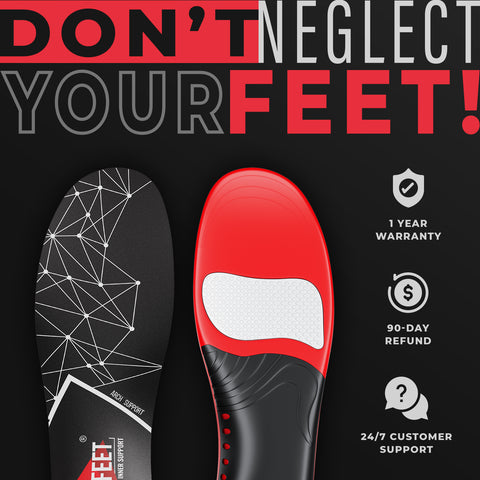Repetitive stress and overloading on the plantar fascia ligament and the arch of the foot causes plantar fasciitis (also known as heel pain or arch discomfort). When this happens, the tissue in and around the heel bone overcompensates, resulting in discomfort, edema, and inflammation. Proper foot structure and function, including correcting posture and using insoles, or orthotics, for foot support and arch support, are the keys to prevention.
Plantar fasciitis causes discomfort, inflammation, and a loss of motion in the heel, especially after lengthy periods of standing or walking. Heel spurs or heel discomfort are other names for it. This is because the plantar fasciitis arch has changed dramatically over time, losing most of its autonomous strength and function. The arch of the foot supports the body's weight and allows the lower legs to bend. Over time, this persistent internal pressure causes a rip in the arch.

There will be less strain on the arch with adequate arch support and foot structure, as well as improved pain reduction and flexibility. The situation will worsen if these issues are not addressed. Plantar fasciitis can be caused by wearing shoes that are too high or utilizing ineffective insoles. Orthotic insoles, which are bespoke orthotics built for your specific body type and foot function, may be recommended by your doctor.
The heel cup, which is an insole or shoe insert that is inserted in the heel cup portion of the shoe, is a frequent orthotic. This helps to avoid heel spurs by providing more arch support. With the usage of this orthotic, many people have reported enhanced comfort and even pain alleviation. EASYFEET arch supportive footwear, which has a flexible midsole as well as arch supports, is another alternative. When walking, this sort of shoe provides added stability. These can be a useful option for persons who have significant foot pain or other foot problems.
If you have plantar fasciitis discomfort in your insoles, you should try using an orthotic insole for increased arch support and pain alleviation. Walking can also be done with these insoles. If you pick this style of shoe, consult your doctor to see if an orthotic insole in combination with an arch support shoe is acceptable. Many people find that wearing a plantar fasciitis pain insole in their shoe relieves their pain and helps them avoid the discomfort that comes with this ailment.
Pain, swelling, redness, and inflammation are some of the indications and symptoms of foot inflammation. The discomfort and swelling are usually greatest at night and when the joint is moved. You might also have issues walking, jogging, or doing other simple activities.
To gain immediate relief from pain symptoms, use a heating pad over the troublesome spot. Ibuprofen, an over-the-counter or prescription pain medication, is fine for short-term use. Try incorporating a few stretches into your daily routine, such as toe stretching or arch stretching. Strengthening the various muscles of your feet can help avoid fasciitis by focusing on them.

If you have inflammation, the best thing you can do is rest the area and avoid wearing shoes or switching to sandals until the inflammation has subsided. Plantar fasciitis is best treated by avoiding it in the first place. Wear appropriate footwear for your activity, especially if you will be walking on hard surfaces such as concrete, tile, asphalt, or wood. Also, after a vigorous workout, change your shoes.
EASYFEET arch supportive insoles are the most popular, podiatrist-approved devices for relieving plantar fasciitis discomfort. Combine our insoles with stretching during the day and braces or splints at night to relieve and prevent pain.

2 comments
Dear Faye,
Thanks for contacting us!
We recommend orthotic insoles for you, considering your foot diseases.
Our best-selling model – EASYFEET Black insoles provide strong arch support and shock-absorption cushioning. Most of our clients get pain relief in 7 days. People who have different foot pathologies, as well as heel spurs, bunion, and plantar fasciitis, note a decrease in pain, improvement in their well-being, a gain in self-confidence, and a good mood after using EASYFEET Black insoles on a daily basis. We recommend wearing these insoles for a couple of hours a day for the first week and then gradually increasing each day to get used to the insoles and feel all benefits.
Please be aware we always recommend consulting your physician or podiatrist before purchasing.
Hope it will help you to make the right decision.
Hello I have PTTD. Along with this | have heal spurs (both feet) bunion (both feet) both were operated on, right one came back. Hammer toes (both feet) right foot has not been operated on Had plantar fasciitis surgery on the left foot. Can you recommend a orthotic for me?